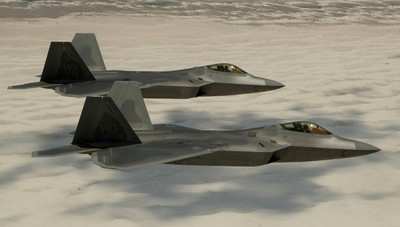Fri, May 18, 2012
All Flights To Be Conducted Near Potential Landing Locations
With safety remaining his top concern, Defense Secretary Leon E. Panetta (pictured) has ordered the Air Force to take additional steps to mitigate risks to F-22 pilots, George Little, acting assistant secretary of defense for public affairs, said Wednesday. Beginning in 2008, a few pilots experienced hypoxia-like symptoms when flying the aircraft, Little told reporters at a Pentagon news conference. Hypoxia is a deficiency of oxygen. There have been a total of 12 cases of these hypoxia-like symptoms affecting pilots.

Little said the secretary has followed developments in the F-22 closely and has directed the Air Force to expedite the installation of an automatic backup oxygen system in all of the planes. In addition, effective immediately, all F-22 flights will remain near potential landing locations to enable quick recovery and landing should a pilot encounter unanticipated physiological conditions during flight” Little said.
Finally, Panetta directed the Air Force to provide him with a monthly progress report as the service continues the search for the root cause of the problem.
These steps are in addition to the measures the Air Force is already taking to determine the root causes of the hypoxia-like symptoms pilots have experienced.
Panetta made this decision in part due to the reluctance of some pilots to fly the aircraft, Little said. “Secretary Panetta believes the department must do everything possible to ensure pilot safety and minimize flight risks,” Little said.
The Armed Forces Press Service reports that the secretary’s directions take into account the need for determining the cause of the problem, while still allowing the military to use the unique capabilities provided by the F-22 Raptor. The aircraft are based in the United States and are now deployed to Southwest Asia, Little said. As the only fifth-generation aircraft in the world, he added, the plane is the most capable fighter in the air and is necessary to maintain U.S. air dominance. “Safety is a zero-sum game,” Pentagon spokesman Navy Capt. John Kirby said at the news conference. The automatic backup oxygen system will complete testing by the end of November, with installation in line fighters beginning in December. Ten Raptors will be retrofitted with this system per month, he said.

Keeping the F-22 fleet flying allows the service to examine the aircraft closely. “There’s a troubleshooting process going on right now,” Kirby said. “So the aircraft being in operation assists that process. We believe we’ve mitigated the risks as much as possible.” But safety is the paramount concern, he said, and if he needs to, the secretary will ground the fleet. “But right now, he believes … this is the right course,” Kirby said.
The Air Force has been studying the problem since 2008. “The root cause of hypoxia-like events has not been determined,” Little said. “It is possible … that it could be attributed to the oxygen system in the airplane – thus the installation of a backup system. But it could have other causes, too, and the Air Force is aggressively looking at other factors that could be contributing.”
More News
Also: Centauri Aircraft Valkyrie, Meet the Admin, Night Airshow, Pelton Intv'w When we laid eyes on this critter, we fell in love… and then we learned the amazing story of t>[...]
Check out Blackshape in Oshkosh Display #190 Situated in the Apulian Aerospace district in Monopoli, Italy, Blackshape embodies the epitome of Italian craftsmanship, style, and qua>[...]
A Powerhouse In Aviation Safety Technology, Visit Alpha Systems AOA at Osh Display#3124-3125 Alpha systems AOA has been developing and integrating Angle of Attack systems for the l>[...]
High-Flying Models By PilotMall.com: Honoring Aviation's Legacy We are dedicated to preserving and celebrating our rich aviation heritage through stunning mahogany wood scale repli>[...]
CiES Has Pioneered Life Saving Technology Of Use To Pilots All Over The World... Booth 3119 CiES: CiES Inc. is the global leader in digital fuel quantity sensors for general aviati>[...]
 OSH25 Day Four Redux: Spirit SE-1!, H55 eFlyer, King Schools
OSH25 Day Four Redux: Spirit SE-1!, H55 eFlyer, King Schools ANN Thanks Our Speedy Sponsor... Blackshape!!!
ANN Thanks Our Speedy Sponsor... Blackshape!!! Alpha Systems AOA Guides ANN Oshkosh Coverage
Alpha Systems AOA Guides ANN Oshkosh Coverage Pilot Mall Intro's High Flying Models To ANN Sponsor Lineup
Pilot Mall Intro's High Flying Models To ANN Sponsor Lineup CiES Fuels ANN's Oshkosh 2025 Special Event Coverage
CiES Fuels ANN's Oshkosh 2025 Special Event Coverage




